Which Scene in Mice and Men Includes Slilence Being Personified Again and Again
Demand to analyze The Carmine Letter or To Kill a Mockingbird for English grade, merely fumbling for the right vocabulary and concepts for literary devices? You've come up to the correct place. To successfully interpret and analyze literary texts, y'all'll first need to have a solid foundation in literary terms and their definitions. In this article, we'll assist you get familiar with about commonly used literary devices in prose and verse. We'll requite yous a articulate definition of each of the terms nosotros hash out along with examples of literary elements and the context in which they near frequently announced (comedic writing, drama, or other). Before we get to the list of literary devices, however, we have a quick refresher on what literary devices are and how understanding them volition assist you analyze works of literature. Literary devices are techniques that writers use to create a special and pointed effect in their writing, to convey information, or to help readers understand their writing on a deeper level. Often, literary devices are used in writing for emphasis or clarity. Authors will also use literary devices to get readers to connect more strongly with either a story as a whole or specific characters or themes. So why is it important to know different literary devices and terms? Aside from helping you get good grades on your literary analysis homework, there are several benefits to knowing the techniques authors unremarkably apply. Being able to identify when different literary techniques are being used helps you understand the motivation behind the writer's choices. For example, existence able to identify symbols in a story can help yous figure out why the writer might have chosen to insert these focal points and what these might suggest in regard to her attitude toward certain characters, plot points, and events. In addition, being able to identify literary devices can make a written work's overall meaning or purpose clearer to you lot. For instance, let'southward say y'all're planning to read (or re-read) The King of beasts, the Witch, and the Wardrobe by C.S. Lewis. Past knowing that this particular book is a religious apologue with references to Christ (represented by the character Aslan) and Judas (represented by Edmund), it will exist clearer to you why Lewis uses certain linguistic communication to describe certain characters and why certain events happen the style they practice. Finally, literary techniques are important to know because they brand texts more interesting and more fun to read. If you were to read a novel without knowing whatever literary devices, chances are you wouldn't exist able to discover many of the layers of meaning interwoven into the story via different techniques. Now that we've gone over why you should spend some time learning literary devices, let'south take a await at some of the nigh important literary elements to know. Below is a list of literary devices, most of which you'll oft come across in both prose and poetry. We explain what each literary term is and requite you an example of how it's used. This literary elements list is arranged in alphabetical order. An allegory is a story that is used to correspond a more general message about existent-life (historical) problems and/or events. It is typically an entire volume, novel, play, etc. Example: George Orwell'due south dystopian volume Beast Subcontract is an allegory for the events preceding the Russian Revolution and the Stalinist era in early 20th century Russia. In the story, animals on a farm practice animalism, which is essentially communism. Many characters correspond to bodily historical figures: Old Major represents both the founder of communism Karl Marx and the Russian communist leader Vladimir Lenin; the farmer, Mr. Jones, is the Russian Czar; the boar Napoleon stands for Joseph Stalin; and the pig Snowball represents Leon Trotsky. Alliteration is a series of words or phrases that all (or virtually all) start with the same sound. These sounds are typically consonants to give more stress to that syllable. You'll often come across alliteration in poetry, titles of books and poems (Jane Austen is a fan of this device, for example—just look at Pride and Prejudice and Sense and Sensibility), and tongue twisters. Instance: "Peter Piper picked a peck of pickled peppers." In this tongue twister, the "p" sound is repeated at the beginning of all major words. Allusion is when an writer makes an indirect reference to a figure, place, event, or idea originating from outside the text. Many allusions make reference to previous works of literature or fine art. Example: "Cease interim so smart—information technology'southward not similar you're Einstein or something." This is an innuendo to the famous existent-life theoretical physicist Albert Einstein. An anachronism occurs when there is an (intentional) error in the chronology or timeline of a text. This could exist a character who appears in a unlike time period than when he really lived, or a technology that appears before it was invented. Anachronisms are often used for comedic effect. Case: A Renaissance king who says, "That's dope, dude!" would be an anachronism, since this type of language is very mod and not really from the Renaissance period. Anaphora is when a discussion or phrase is repeated at the beginning of multiple sentences throughout a piece of writing. It'south used to emphasize the repeated phrase and evoke strong feelings in the audience. Example: A famous instance of anaphora is Winston Churchill's "We Shall Fight on the Beaches" speech. Throughout this speech, he repeats the phrase "we shall fight" while listing numerous places where the British army will continue contesting during WWII. He did this to rally both troops and the British people and to requite them confidence that they would however win the war. An anthropomorphism occurs when something nonhuman, such as an creature, identify, or inanimate object, behaves in a human-like way. Example: Children's cartoons accept many examples of anthropomorphism. For example, Mickey and Minnie Mouse can speak, article of clothing clothes, sing, dance, drive cars, etc. Real mice tin't practise whatsoever of these things, but the ii mouse characters acquit much more similar humans than mice. Asyndeton is when the author leaves out conjunctions (such every bit "and," "or," "merely," and "for") in a grouping of words or phrases so that the meaning of the phrase or sentence is emphasized. It is often used for speeches since sentences containing asyndeton can have a powerful, memorable rhythm. Instance: Abraham Lincoln ends the Gettysburg Address with the phrase "...and that government of the people, by the people, for the people shall not perish from the World." By leaving out sure conjunctions, he ends the speech on a more powerful, melodic note. Colloquialism is the employ of informal language and slang. It's ofttimes used by authors to lend a sense of realism to their characters and dialogue. Forms of colloquialism include words, phrases, and contractions that aren't real words (such as "gonna" and "own't"). Example: "Hey, what'south upward, man?" This piece of dialogue is an example of a colloquialism, since it uses common everyday words and phrases, namely "what's up" and "homo." An epigraph is when an writer inserts a famous quotation, verse form, vocal, or other curt passage or text at the beginning of a larger text (e.yard., a book, affiliate, etc.). An epigraph is typically written by a different writer (with credit given) and used as a way to introduce overarching themes or messages in the piece of work. Some pieces of literature, such as Herman Melville's 1851 novel Moby-Dick, incorporate multiple epigraphs throughout. Example: At the beginning of Ernest Hemingway's book The Sun Too Rises is an epigraph that consists of a quotation from poet Gertrude Stein, which reads, "Y'all are all a lost generation," and a passage from the Bible. Epistrophe is similar to anaphora, just in this case, the repeated discussion or phrase appears at the end of successive statements. Like anaphora, it is used to evoke an emotional response from the audition. Example: In Lyndon B. Johnson's speech, "The American Promise," he repeats the word "trouble" in a use of epistrophe: "There is no Negro problem. In that location is no Southern trouble. There is no Northern trouble. In that location is just an American trouble." A euphemism is when a more mild or indirect give-and-take or expression is used in place of another word or phrase that is considered harsh, edgeless, vulgar, or unpleasant. Instance: "I'm so sorry, merely he didn't brand it." The phrase "didn't make it" is a more than polite and less blunt style of saying that someone has died. A flashback is an intermission in a narrative that depicts events that accept already occurred, either earlier the nowadays time or earlier the time at which the narration takes place. This device is often used to requite the reader more than background information and details well-nigh specific characters, events, plot points, and so on. Instance: Nearly of the novel Wuthering Heights past Emily Brontë is a flashback from the indicate of view of the housekeeper, Nelly Dean, as she engages in a conversation with a company named Lockwood. In this story, Nelly narrates Catherine Earnshaw's and Heathcliff's childhoods, the pair's budding romance, and their tragic demise. Foreshadowing is when an author indirectly hints at—through things such as dialogue, description, or characters' deportment—what's to come later on in the story. This device is often used to introduce tension to a narrative. Example: Say you're reading a fictionalized account of Amelia Earhart. Before she embarks on her (what we know to be unfortunate) plane ride, a friend says to her, "Be safe. Wouldn't want you lot getting lost—or worse." This line would be an case of foreshadowing because it implies that something bad ("or worse") volition happen to Earhart. Hyperbole is an exaggerated statement that'southward non meant to be taken literally by the reader. It is often used for comedic event and/or emphasis. Example: "I'm then hungry I could eat a horse." The speaker volition not literally eat an entire equus caballus (and near likely couldn't), merely this hyperbole emphasizes how starved the speaker feels. Imagery is when an writer describes a scene, thing, or thought so that it appeals to our senses (taste, aroma, sight, touch, or hearing). This device is often used to help the reader conspicuously visualize parts of the story by creating a strong mental picture. Case: Here'southward an example of imagery taken from William Wordsworth'due south famous verse form "I Wandered Lonely every bit a Cloud": When all at once I saw a oversupply, Irony is when a argument is used to limited an reverse meaning than the i literally expressed past it. There are 3 types of irony in literature: Examples: Juxtaposition is the comparing and contrasting of two or more different (usually opposite) ideas, characters, objects, etc. This literary device is ofttimes used to help create a clearer picture of the characteristics of one object or thought by comparing it with those of some other. Example: 1 of the most famous literary examples of juxtaposition is the opening passage from Charles Dickens' novel A Tale of Ii Cities: "Information technology was the all-time of times, information technology was the worst of times, it was the historic period of wisdom, it was the age of foolishness, it was the epoch of belief, it was the epoch of incredulity, it was the season of Light, it was the season of Darkness, it was the leap of hope, it was the winter of despair …" Malapropism happens when an incorrect word is used in place of a discussion that has a similar sound. This misuse of the give-and-take typically results in a statement that is both nonsensical and humorous; every bit a event, this device is normally used in comedic writing. Instance: "I merely can't look to dance the flamingo!" Hither, a graphic symbol has accidentally called the flamenco (a blazon of dance) the flamingo (an animal). Metaphors are when ideas, actions, or objects are described in non-literal terms. In short, it's when an author compares one thing to another. The two things beingness described usually share something in common but are unalike in all other respects. A simile is a blazon of metaphor in which an object, idea, character, activeness, etc., is compared to another thing using the words "as" or "similar." Both metaphors and similes are oftentimes used in writing for clarity or emphasis. Examples: "What lite through yonder window breaks? It is the east, and Juliet is the sunday." In this line from Romeo and Juliet, Romeo compares Juliet to the sun. However, because Romeo doesn't use the words "every bit" or "similar," it is not a simile—only a metaphor. "She is as cruel every bit a king of beasts." Since this statement uses the word "as" to make a comparison between "she" and "a lion," information technology is a simile. Demand more help with this topic? Check out Tutorbase! Our vetted tutor database includes a range of experienced educators who tin can help y'all polish an essay for English or explicate how derivatives work for Calculus. Yous can apply dozens of filters and search criteria to find the perfect person for your needs. A metonym is when a related word or phrase is substituted for the bodily thing to which information technology's referring. This device is commonly used for poetic or rhetorical consequence. Case: "The pen is mightier than the sword." This statement, which was coined by Edward Bulwer-Lytton in 1839, contains two examples of metonymy: "the pen" refers to "the written word," and "the sword" refers to "military force/violence." Mood is the general feeling the author wants the audition to have. The writer tin achieve this through description, setting, dialogue, and word selection. Example: Hither's a passage from J.R.R. Tolkien's The Hobbit: "It had a perfectly round door similar a porthole, painted greenish, with a shiny yellowish brass knob in the exact middle. The door opened on to a tube-shaped hall similar a tunnel: a very comfortable tunnel without smoke, with panelled walls, and floors tiled and carpeted, provided with polished chairs, and lots and lots of pegs for hats and coats -- the hobbit was fond of visitors." In this passage, Tolkien uses detailed description to set create a cozy, comforting mood. From the writing, you can see that the hobbit'southward home is well-cared for and designed to provide comfort. Onomatopoeia is a discussion (or group of words) that represents a sound and actually resembles or imitates the sound information technology stands for. It is oft used for dramatic, realistic, or poetic upshot. Examples: Fizz, boom, chirp, creak, sizzle, zoom, etc. An oxymoron is a combination of two words that, together, limited a contradictory meaning. This device is often used for accent, for sense of humour, to create tension, or to illustrate a paradox (run across next entry for more data on paradoxes). Examples: Deafening silence, organized chaos, cruelly kind, insanely logical, etc. A paradox is a statement that appears illogical or cocky-contradictory but, upon investigation, might actually be true or plausible. Note that a paradox is different from an oxymoron: a paradox is an entire phrase or sentence, whereas an oxymoron is a combination of just two words. Case: Here'due south a famous paradoxical sentence: "This argument is faux." If the statement is truthful, so it isn't actually false (every bit it suggests). But if information technology's false, and then the statement is true! Thus, this statement is a paradox because it is both true and false at the same time. Personification is when a nonhuman figure or other abstract concept or element is described equally having man-like qualities or characteristics. (Unlike anthropomorphism where non-human figures get human being-like characters, with personification, the object/effigy is just described every bit beingness human-like.) Personification is used to help the reader create a clearer mental picture of the scene or object beingness described. Example: "The wind moaned, beckoning me to come up outside." In this example, the wind—a nonhuman element—is beingness described equally if it is man (it "moans" and "beckons"). Repetition is when a word or phrase is written multiple times, usually for the purpose of emphasis. It is often used in verse (for purposes of rhythm equally well). Case: When Lin-Manuel Miranda, who wrote the score for the hit musical Hamilton, gave his speech at the 2016 Tony's, he recited a verse form he'd written that included the following line: And love is love is love is love is dear is dear is love is beloved cannot be killed or swept bated. Satire is genre of writing that criticizes something, such equally a person, behavior, belief, government, or society. Satire frequently employs irony, humor, and hyperbole to brand its point. Example: The Onion is a satirical paper and digital media company. It uses satire to parody common news features such as stance columns, editorial cartoons, and click bait headlines. A blazon of monologue that's frequently used in dramas, a soliloquy is when a character speaks aloud to himself (and to the audience), thereby revealing his inner thoughts and feelings. Case: In Romeo and Juliet, Juliet's speech on the balcony that begins with, "O Romeo, Romeo! Wherefore art thou Romeo?" is a soliloquy, every bit she is speaking aloud to herself (remember that she doesn't realize Romeo'southward there listening!). Symbolism refers to the use of an object, figure, upshot, state of affairs, or other thought in a written work to represent something else—typically a broader bulletin or deeper meaning that differs from its literal meaning. The things used for symbolism are called "symbols," and they'll ofttimes announced multiple times throughout a text, sometimes irresolute in meaning as the plot progresses. Example: In F. Scott Fitzgerald'south 1925 novel The Great Gatsby, the green low-cal that sits across from Gatsby's mansion symbolizes Gatsby's hopes and dreams. A synecdoche is a literary device in which role of something is used to represent the whole, or vice versa. It's similar to a metonym (see in a higher place); however, a metonym doesn't have to correspond the whole—only something associated with the give-and-take used. Example: "Help me out, I need some easily!" In this example, "hands" is being used to refer to people (the whole human, essentially). While mood is what the audience is supposed to feel, tone is the writer or narrator's attitude towards a subject. A good writer will ever desire the audience to feel the mood they're trying to evoke, but the audience may non always agree with the narrator's tone, specially if the narrator is an unsympathetic character or has viewpoints that differ from those of the reader. Example: In an essay disdaining Americans and some of the sites they visit as tourists, Rudyard Kipling begins with the line, "Today I am in the Yellowstone Park, and I wish I were dead." If y'all bask Yellowstone and/or national parks, yous may not hold with the writer'southward tone in this piece. In lodge to fully translate pieces of literature, you accept to understand a lot about literary devices in the texts you read. Hither are our top tips for identifying and analyzing different literary techniques: First off, you'll need to make certain that you're reading very carefully. Resist the temptation to skim or skip any sections of the text. If you do this, you might miss some literary devices being used and, every bit a result, will be unable to accurately translate the text. If there are any passages in the work that make you feel specially emotional, curious, intrigued, or just manifestly interested, cheque that area once again for any literary devices at play. Information technology's also a good idea to reread whatever parts you idea were disruptive or that you didn't totally understand on a first read-through. Doing this ensures that yous have a solid grasp of the passage (and text equally a whole) and will be able to analyze it appropriately. You won't exist able to identify literary elements in texts if y'all don't know what they are or how they're used, so spend some time memorizing the literary elements list above. Knowing these (and how they expect in writing) volition allow yous to more easily pinpoint these techniques in diverse types of written works. Knowing what kind of audition an writer intended her work to have can help you figure out what types of literary devices might be at play. For example, if you were trying to clarify a children's book, yous'd want to exist on the scout for kid-appropriate devices, such as repetition and alliteration. This is i of the most important tips to know, peculiarly if you're reading and analyzing works for English language class. Every bit you read, take notes on the work in a notebook or on a computer. Write downwards any passages, paragraphs, conversations, descriptions, etc., that spring out at yous or that contain a literary device you were able to identify. You can too take notes directly in the book, if possible (but don't exercise this if you're borrowing a book from the library!). I recommend circling keywords and important phrases, equally well as starring interesting or specially effective passages and paragraphs. Lastly, use sticky notes or post-its to bookmark pages that are interesting to yous or that have some kind of notable literary device. This will assistance yous become back to them afterwards should you lot demand to revisit some of what you've constitute for a paper y'all plan to write. Looking for more than in-depth explorations and examples of literary devices? Join united states as we delve into imagery, personification, rhetorical devices, tone words and mood, and different points of view in literature, as well as some more poetry-specific terms similar assonance and iambic pentameter. Reading The Neat Gatsby for class or even just for fun? And then you'll definitely want to cheque out our skilful guides on the biggest themes in this classic book, from honey and relationships to money and materialism. Got questions about Arthur Miller's The Crucible? Read our in-depth articles to learn near the most important themes in this play and get a complete rundown of all the characters. For more than information on your favorite works of literature, accept a wait at our collection of high-quality book guides and our guide to the 9 literary elements that appear in every story! Desire to amend your SAT score past 160 points or your ACT score by 4 points? We've written a guide for each examination about the top v strategies you must exist using to accept a shot at improving your score. Download information technology for free now: 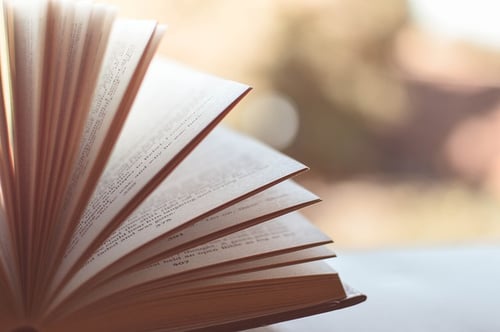
What Are Literary Devices and Why Should You Know Them?
List of Literary Devices: 31 Literary Terms You Should Know
Allegory
Ingemination
Allusion
Anachronism
Anaphora
Anthropomorphism
Asyndeton
Colloquialism
Epigraph
Epistrophe
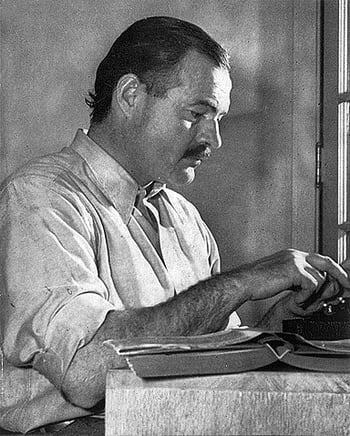 Hemingway, deep in thought about what quotation to choose for his epigraph.
Hemingway, deep in thought about what quotation to choose for his epigraph. Euphemism
Flashback
Foreshadowing
Hyperbole
Imagery
A host of golden Daffodils;
Beside the Lake, beneath the copse,
Fluttering and dancing in the breeze. Irony
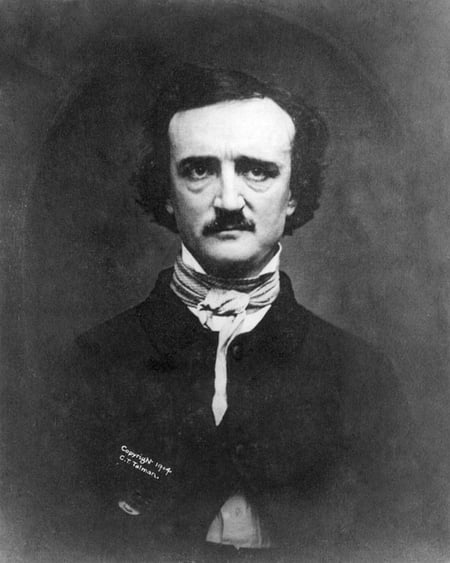 Poe was a fan of irony—and ravens.
Poe was a fan of irony—and ravens. Juxtaposition
Malapropism
Metaphor/Simile

Metonym
Mood
Onomatopoeia
Oxymoron
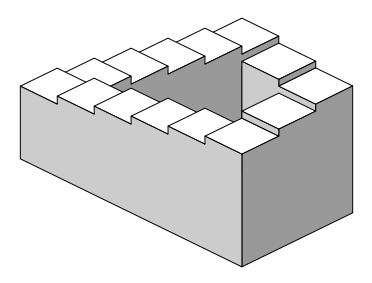 The Penrose stairs = a classic example of a paradox. Are they going up or down?!
The Penrose stairs = a classic example of a paradox. Are they going up or down?! Paradox
Personification
Repetition
Satire
Soliloquy
Symbolism
Synecdoche
Tone
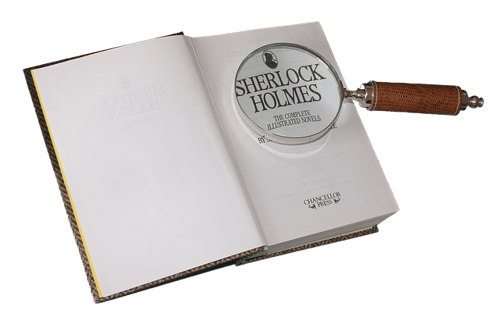 Time to become your ain Sherlock Holmes!
Time to become your ain Sherlock Holmes! How to Place and Analyze Literary Devices: four Tips
Tip ane: Read Closely and Carefully
Tip 2: Memorize Common Literary Terms
Tip 3: Know the Author's Intended Audience
Tip 4: Have Notes and Bookmark Key Passages and Pages
What'southward Next?



About the Author
Hannah received her MA in Japanese Studies from the University of Michigan and holds a bachelor's caste from the University of Southern California. From 2013 to 2015, she taught English in Nihon via the JET Program. She is passionate about pedagogy, writing, and travel.
stampleyweref2001.blogspot.com
Source: https://blog.prepscholar.com/list-of-literary-devices-techniques
0 Response to "Which Scene in Mice and Men Includes Slilence Being Personified Again and Again"
Post a Comment